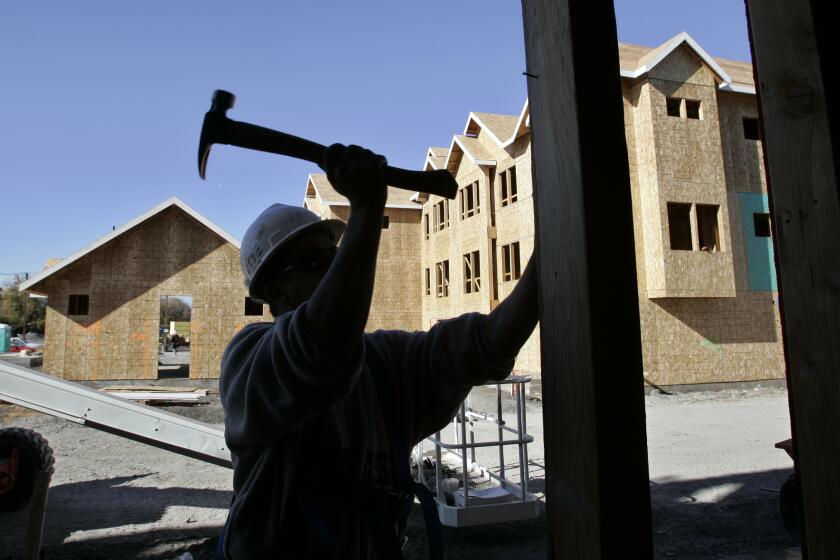Porter Ranch Builder’s Acts Speak Louder Than Words
Nathan Shapell is a man of few words. Even at the festive opening of a new subdivision at his Porter Ranch development earlier this month, with hundreds of people in attendance, he declined to address the crowd.
His reluctance to give speeches, however, does not mean Shapell has no strong views. The balding, barrel-chested developer reacts quickly when asked whether home building should be concentrated in outlying suburbs like Porter Ranch, or in the urban core.
“Both,” he said emphatically, in his heavily accented English, “because people need housing.”
Despite his outward reserve, Shapell, 77, has had a high-profile career as both a home builder and a public official. In the past four decades, the Beverly Hills resident and Holocaust survivor has built about 50,000 homes in California.
“He is a giant in the California home-building industry, on the level of Ray Watt, John Lusk and Eli Broad,” said Randall Lewis, executive vice president of Kaufman & Broad Home Corp. of Los Angeles.
In the San Fernando Valley, Shapell’s role as developer of Porter Ranch qualifies him as a major developer. After starting Porter Ranch exclusively as a housing community, Shapell sought in the late 1980s to expand the development into a major commercial center as well.
After several years of controversy, the Los Angeles City Council approved a master plan that would allow 3,395 residences, including 2,195 single-family homes. Porter Ranch is also zoned for 6 million square feet of stores, office buildings and other types of commercial development.
Shapell is also a political insider with plentiful pull at City Hall. At the recent opening of the high-end Renaissance subdivision at Porter Ranch, the home builder mugged for photographs with Mayor Richard Riordan, City Council President John Ferraro, Councilman Hal Bernson and Police Chief Bernard Parks--an impressive collection for a more-or-less routine subdivision opening.
Shapell, in particular, has been a major supporter of Bernson, who represents the Porter Ranch area; in the 1980s alone, the councilman received more than $50,000 in campaign contributions from Shapell’s companies.
If Shapell is not talkative, he is forthright when it’s pointed out that he’s able to retire comfortably whenever he chooses.
“Financially, you are right,” he said. “I might have retired a long time ago, but [home building] is a part of me.”
“He is a very astute businessman who would have been successful in any field,” said Irving Feintech, president of Liberty Building Co., the Beverly Hills-based general contractor that has built Shapell’s projects since the early 1970s.
As a manager, Shapell is “very involved, but he can delegate [responsibility],” Feintech added.
Despite a very active career in home building, Shapell is not a single-minded businessman. Two years ago, he retired from the board of the state’s Little Hoover Commission after nearly 30 years; for much of that time, he served as chairman of California’s official watchdog commission.
During his tenure as chairman, the commission completed 110 studies and issued an equal number of reports. Among the accomplishments cited by the panel is the creation of a Medi-Cal “czar” who has saved $2 billion for the state, new laws to raise standards in nursing homes, a system of property management for state-owned real estate, and reforms in education spending.
An affordable-housing advocate who worked with Shapell on a housing task force in the 1980s recalled him as a blunt-spoken man with conservative views.
“He was tough, impetuous, fairly strident, with no words being minced,” said Christine Minnehan, currently a housing advocate for the Western Center on Law and Poverty.
“Nate and I mixed it up a number of times” on such issues as rent control and tenants’ rights, she added.
Despite their ideological differences, “it was quite clear that there was a real desire on his part to provide housing to poor tenants,” Minnehan said.
“At the end of our work together,” she added, Shapell was “not only gracious, but took a fair number of recommendations [made by] the Western Center and incorporated them into the final report to [then] Gov. Brown.”
She eventually “found the compassion that was buried under his gruff demeanor and his desire to shift the balance [of poverty] was a genuine part of the person.”
Shapell is also active in philanthropy, building schools both in the Los Angeles area and in Israel. He and Feintech donated the funds for a new private junior high school operated by Stephen Wise Temple in Bel-Air, as well as an administrative building for the temple high school.
Shapell’s interest in philanthropy and public policy may have been influenced by his difficult early history. The European-born Shapell has described himself as a graduate of Auschwitz.
Shapell was a teenager in Poland when the Nazis invaded and began to persecute the Jewish population. His father was killed, and his mother deported to the Targowa ghetto. In a memoir, “Witness to the Truth,” Shapell described smuggling food into the ghetto to aid his mother, while helping others escape by disguising them with the armbands of the city sanitation department he worked for. He also helped children escape by concealing them in large soup kettles.
Later, Shapell was deported to Auschwitz-Birkenau, and survived forced marches to subsequent concentration camps, Guenthergrube and Waldenburg. He was 23 at the end of the war, and spent the rest of the 1940s building what he described as a community for thousands of refugees and camp survivors.
In the early 1950s, Shapell, his wife and young daughter immigrated to the United States. With his brother David and his brother-in-law Max Webb, Shapell started a home-building business. Webb and Nathan Shapell remain partners.
At the lavish banquet for the luxury Renaissance homes in Porter Ranch, the death camps seemed far away. Shapell described the new homes, the most expensive yet built at Porter Ranch, as his favorite project; the almost manorial houses can cost as much as $749,000.
Later, he corrected himself. “They’re all my favorites,” he said of all his projects.
Shapell said he prides himself on the quality of construction and that it is equally good, no matter the variance in price. After the Northridge earthquake, he said, “we only had two houses that were injured, and by injuries I mean the chimneys [were damaged],” he said.
What he most enjoys, Shapell said, is to see how home buyers react to their homes after they move in. “This is important to me, that the people should be satisfied,” he said.
More to Read
Sign up for Essential California
The most important California stories and recommendations in your inbox every morning.
You may occasionally receive promotional content from the Los Angeles Times.






